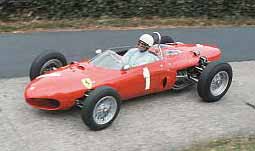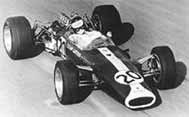->1960 - 1969<-
The 1960s began as the 1950s had ended with Australian Jack Brabham winning the World Championship. His Cooper Climax, thanks to its mid-engine design, continued to dictate the pace. The successful Type T53 was powered by a 240 hp four-cylinder unit which could pull the 440 kg vehicle to nearly 300 km/h.
Formula One saw a traditional front-engined old-timer win for the last time, when the British teams stayed away from the Italian Grand Prix because they feared the dreaded steep curves of Monza. American Phil Hill snatched victory at the wheel of his Ferrari 246, a historic win which granted him a place among the all-time greats.
-> 1961: the 156 shark nose, the first rear engined Ferrari
1960 was a season which highlighted the dangerous nature of Grand Prix racing in the early years. Two drivers died during the Belgian Grand Prix in Spa and two more were seriously injured. The highly talented Chris Bristow lost control of his Cooper and did not survive the subsequent terrible cartwheeling. The second tragedy was the death of Alan Stacey. The Lotus driver left the track because a bird flew into his face at top speed - full-visor helmets did not come into use until eight years later...

In order to reduce the dangers, the maximum engine capacity of the vehicles was brought from 2.5 litres down to 1.5 litres at the start of the 1961 season. At the same time, the oil suppliers succeeded in their campaign to enforce the use of standard fuels. The CSI, the sports department of the FIA in those days, stipulated that cars be tanked with commercial grade petrol with an octane rating of no more than 100. At the same time, the chemical engineers were working intensively at the Shell Research Centre in Thornton, England, on the development of the BRM eight-cylinder engine, which would not have to wait much longer for success.
1961, however, was the year of Scuderia Ferrari. The Tipo 156, with its legendary shark's nose, was powered by a 190 hp engine, and neither Climax nor Porsche could keep up with it. The air-cooled four-cylinder unit from Germany developed a mere 160 hp, and the Climax engines even less. Thanks to the power of their six-cylinder cars, Ferrari drivers Phil Hill, Wolfgang von Trips and Richie Ginther ran rings around the competition. In Belgium, where the local star Olivier Gendebein complemented the trio, the Scuderia even managed to secure a triumphant quadruple win. Only in Monaco and on the North Circuit of the Nurburgring was Ferrari forced to give way: on these two superbly challenging tracks, Stirling Moss succeeded in tricking his way to victory over the Reds in his Lotus-Climax.
Phil Hill, the front-engine veteran, was the first American to become World Champion, although tears were shed in his hour of victory. At Monza, von Trips - who was right at the top of the rankings after wins in Zandvoort and Aintree - started in pole position for the first time. But the good starting position brought no joy to the German. After a bad start he collided with the young Scottish star Jim Clark and lost his life in the resulting accident.
-> 1963: Jim Clark driving the Lotus 25, the first monocoque chasis
In 1962, Ferrari stood in the shade of the British competition. Climax and BRM began to use an eight-cylinder engine from the start of the season. This was the era during which the carburettor engine was ousted once and for all. Despite the switch-over from aviation fuel to commercial grade petrol, 1962 was already experiencing the speeds of 1960. The injection engines were unstoppable.

There had also been a revolution in the chassis building field: Lotus boss Colin Chapman, one of Formula One's pioneering engineers, presented his famous Lotus 25 in 1962. It was the first single-seater ever to be made using the Monocoque construction method. Instead of the traditional tubular frame, riveted light metal boxes were employed. The result was a highly torsion resistant chassis which offered relatively good protection for the driver. The driver no longer sat in the cockpit - he lay almost completely flat on his back. What's more, the tiny steering wheels common now in Formula One were also introduced at that time. Only Ferrari retained the big wooden steering wheels for one more year which, looking back, were reminiscent of something from the Tale of the Ancient Mariner...
The BRM driver Graham Hill became World Champion in 1962: he won in Holland, Germany, Italy and South Africa. Right up until the last race in South Africa, Hill fought for the World Championship against Jim Clark, who was forced to give up in the final race on account of an engine defect. But Formula One was still stuck deep in the Middle Ages of Grand Prix racing.
It's hard to imagine the events that took place during training on the North Circuit of the Nurburgring. Carel Godin de Beaufort, a Dutchman through and through, had an 8 mm camera mounted on the back of his aged four-cylinder Porsche. On the Fuchsrohre section of the track, where the cars approached the 300 km/h barrier as they drove downhill, the improvised struts holding the camera broke. Graham Hill and Bruce McLaren - later founders of the Super Team - skated over the remnants and spun off into the undergrowth (there were no crash barriers back then). Miraculously, no-one was injured.
-> The first wings were too fragile, and thus banned
By the end of the 1.5 litre formula in 1965 (the remaining World Championship titles went to Jim Clark and Ferrari driver John Surtees), the power of the engines had risen to 220 hp. The small capacity didn't deter the engine builders from employing large numbers of cylinders: Ferrari and Honda had 12-cylinder cars on the starting grid, and Climax even constructed a 16-cylinder engine. The English power pack was rumoured to develop 225 hp, but the cam-shafted boxer never got as far as racing.

Wings appeared on the F1 Cars but seemed too dangerous!
But then a 16-cylinder car did appear, built by BRM, in the second half of the 1960s, as the new 3 litre formula came into play in 1966. The unit developed 400 hp and made such an infernal noise that ear-witnesses are still talking about it today! Despite this, ex-Cooper-driver Jack Brabham beat off all comers at the seat of his Brabham Repco. Based on an Oldsmobile aluminium block and developing 320 hp at 7500 rpm, the Australian eight-cylinder vehicle was the weakest and yet the most reliable of all the engines.
On 4th June 1967, one of the truly historic days of Grand Prix racing, the famous DFV type Ford V8 engine made its debut at Zandvoort. Jim Clark drove the car straight to victory and the unit subsequently developed into an unbeatable series-winner, remaining victorious until the advent of the turbos. Despite this, the 1967 DFV came too late to prevent the Brabham Repco team from achieving another triumph. This time the win went to Jack Brabham's teammate Denis Hulme, who was free from the stall management spoon-feeding of his boss and competitors.
1968 proved unforgettable too. Not just because the great Jim Clark was killed in a Formula Two race on the Hockenheimring; nor was it only on account of the unsuccessful experiments that were conducted with four-wheel-drive cars; neither was it that sponsorship stickers appeared on the cars for the first time. In 1968, Formula One cars grew wings!
-> 1968: Graham Hill at the wheel of a Lotus 49
Their first appearance was as little stumps at the front and back of the vehicle, at Spa-Francorchamps. The aerodynamics engineers soon conquered new ground, though, and within a few weeks, huge wings had materialised, initially on filigree struts at the back, and then similar constructions at the front. But back then it was still impossible to calculate the forces exerted on the surfaces by the wind when driving, and the delicate struts kept breaking. Graham Hill gathered the most points that season and became Champion for the second time.

In 1969 two serious accidents occurred on the picturesque city circuit of Montjuich in Barcelona. The rear wings on the Lotus-Fords of both Hill and Jochen Rindt broke off. The CSI was beyond pardoning anybody. The monstrous wings were banned for the Grand Prix weekend in Monaco. One of the loudest protests came from Ken Tyrrell, team manager of Matra-Ford. Without wings, he said, the cars could not be driven. He was wrong: his driver Jackie Stewart won the Championship without his monster fins!
All the Formula One cars built from 1950 until the end of 1969 had one thing in common: a central air intake in the nose of the car which supplied the engine with combustion and cooling air. This construction dictated the appearance of the traditional Formula One racing car. At that moment, An alternative didn't seem to exist.
It was the genius car-maker Colin Chapman who first entered new territory. He had already created the monocoque design in the early 1960s, which remains universal and indispensable to this day. But with his new Lotus 72 the engineer and team chief did away with the aerodynamically bothersome opening altogether. He made the nose a closed wedge, and the radiators disappeared into the boxes which formed the sides of the car.
Thanks to this pioneering invention, the Lotus 72 could travel 14 km/h faster on long straights than its predecessor the 49C, even with the same power engine. Other features of the racing car were torsion bar suspension and brakes located on the inside. The suspension was based on an idea of the legendary Professor Ferdinand Porsche from the 1930s. Moving the brakes inwards, which was not a Lotus invention either, reduced the unsuspended mass and hence improved road-holding.
BACKhome <---------------------------------